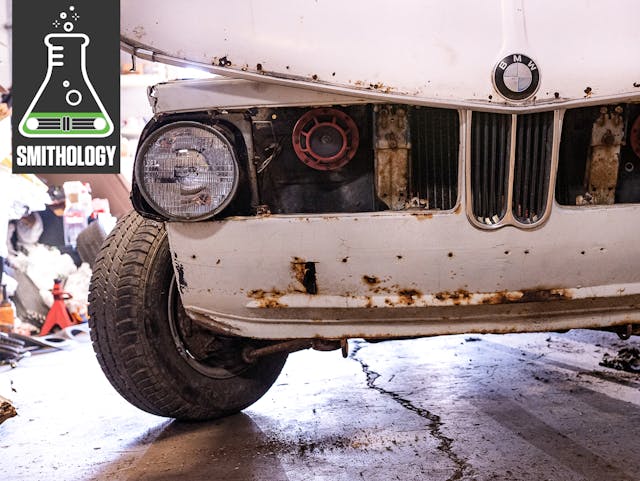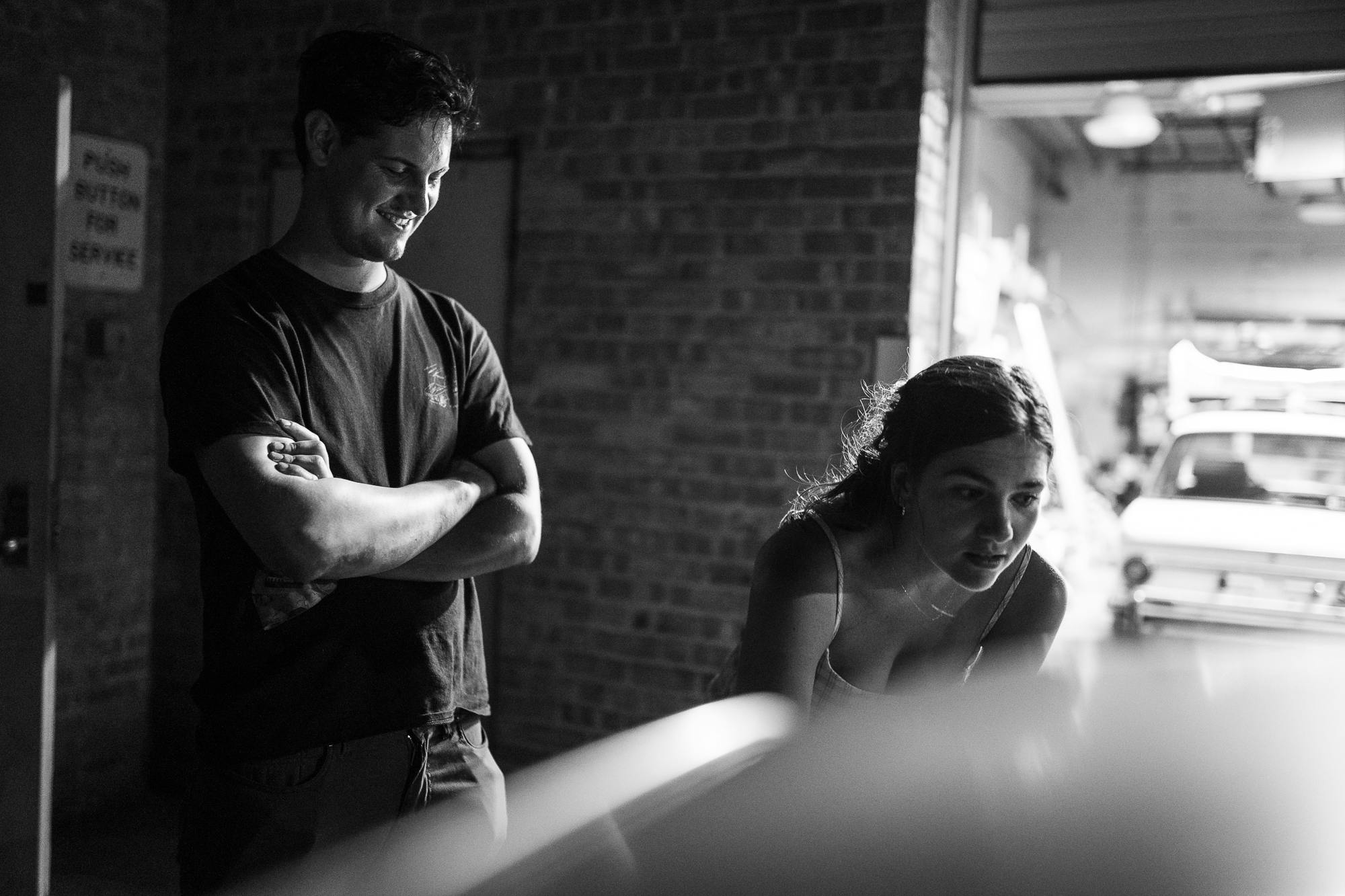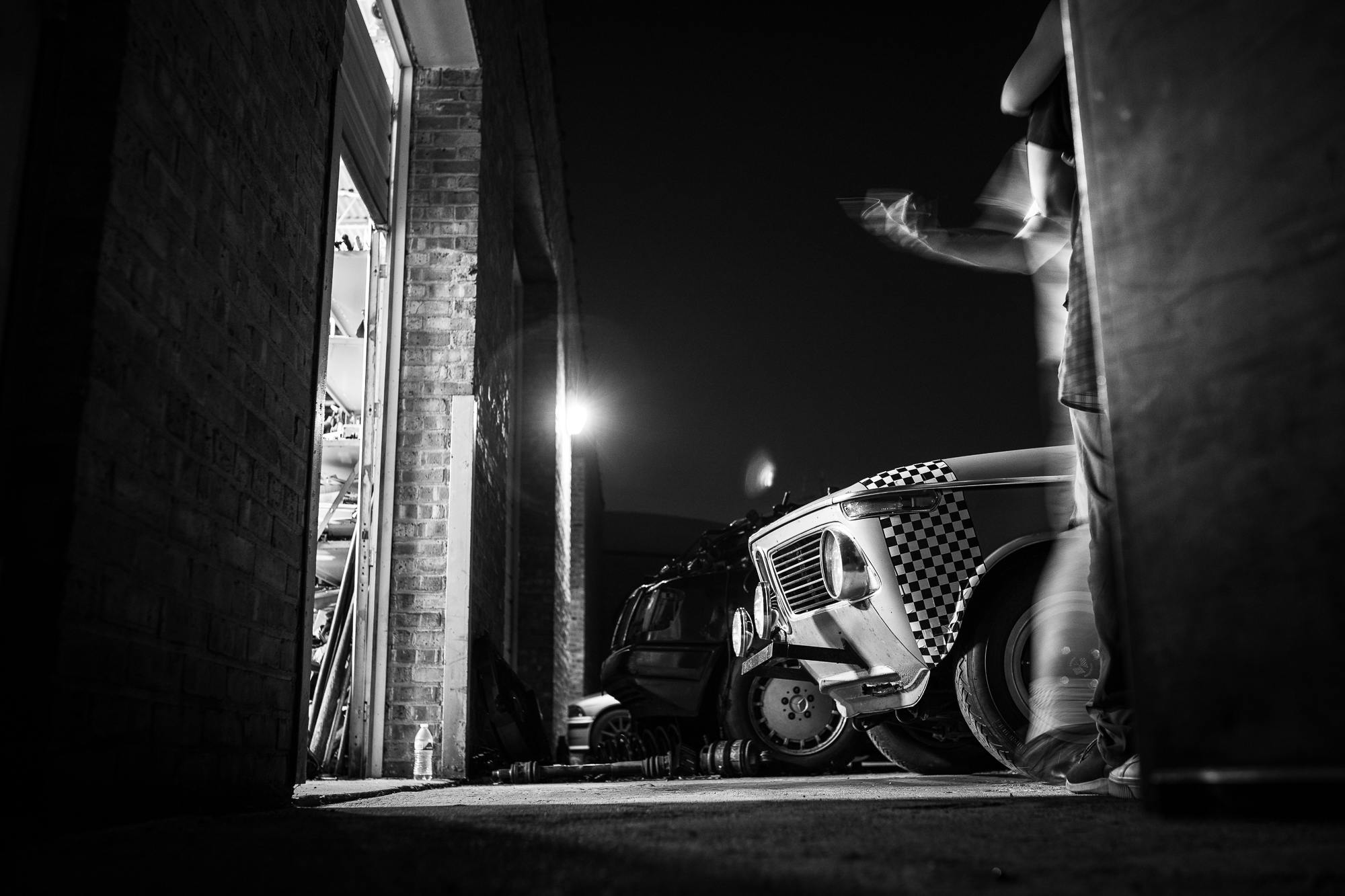Media | Articles
Smithology: I’ve seen tired, and I’ve seen pain
Welcome back to The Weissrat Chronicles, Sam Smith’s tale of dragging an $1800 BMW 2002tii back to life in off-hours and weekends, when he’s not busy testing new cars for Hagerty. This is the third installment in the series, with the chapters best enjoyed in order: One, Two, Three, Four, Five, Six, and Seven. Shorter updates live on Instagram, at @thatsamsmith and the hashtag #weissrat. —Ed.
Paul was crouched in the back seat, face coated in grinding dust, aiming a $9 Harbor Freight heat gun at a fat sheet of floor insulation. Acrid smoke wafted up as the tar in the sheets burned off, tendrils wisping around his glasses. He sighed.
“Why did you buy this piece of crap, again?”
Like a lot of parts guys, my friend Paul Wegweiser has both a warped sense of humor and the ability to look legitimately grumpy on command. His face does this thing best described as I Am Deeply Unimpressed With Both Life and Your Particular Views On It, and anyone in proximity is gifted with the sense that the man is about to either A) turn and walk away, or B) pause, take a deep breath, pull a Zippo from his pocket, and calmly set your shirt on fire.
I leaned into the cockpit, grinning.
Marketplace
Buy and sell classics with confidence
“You literally called me on the phone and told me to buy it.”
Raised eyebrows. “I don’t remember that happening.”

At that instant, someone working in the trunk unloaded on the car with a hammer. Big smacks. Whamwhamwham.
“Not like that. Lemme see it.” My friend Tim.
Louder this time, more determined. WHAM WHAM WHAM. Then Owen’s voice, cheery. “Oh! Okay!” WHAMWHAMWHAM, again.
I popped my head out of the car. The two men were standing behind the rear bumper.
“See?” Tim said, grinning. “Don’t be nice to it.”
I have always depended on the kindness of people who enjoy smacking the hell out of trash with a hammer.
Forty-eight years ago, this car bore no trash. Some diligent individual drove a Riviera Blue 1972 BMW 2002tii off a West German assembly line and into a shipping lot, and shortly after, the car rode a boat to America’s east coast, where it lived for years. After some time, rust came along, and an owner paid for a light restoration and a repaint to white. Miles were added. The rust reappeared; miles kept coming. Ten years ago, the tii was pulled off the road, too perforated to drive, rockers absent, floors torn open, rear shock towers split in half, roof holed, subframe mounts gone, one frame rail composed mostly of air.
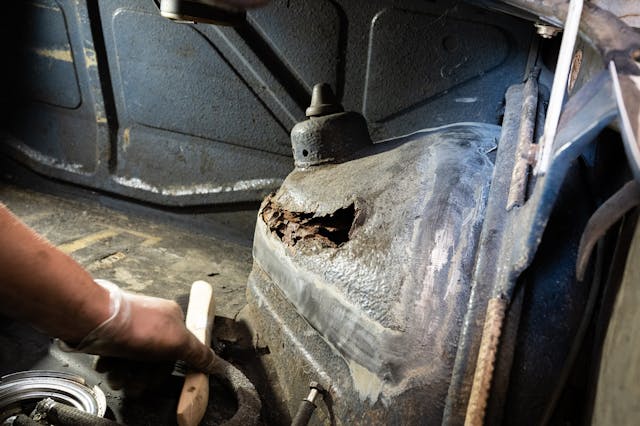
Then, last summer, Paul called me. I woke up one morning, not at all interested in rusty old piles of BMW Dumpster, and by bedtime, I owned one.
This, I believe, is where we left off: thoroughly roached but ostensibly desirable $1800 2002—Factory fuel injection! Early build date! Neato round taillights!—gets zombie-dragged back to life in short order and at short cost. Car that should have been scrap lives again in months. Possibly not without an excess of welding and sheet-metal piracy.
Mark my words, I will drive the hell out of it. To both oceans and Monterey, at least. Maybe Alaska. I have, in the past, done dumber things.
But first, welding.
The project snowballed, as projects do. I dragged the car home to Tennessee. My friend Ben Thongsai, a droll and talented BMW tech in Chicago, offered shop space and help, so I towed the car to Illinois for a few weekends of work.
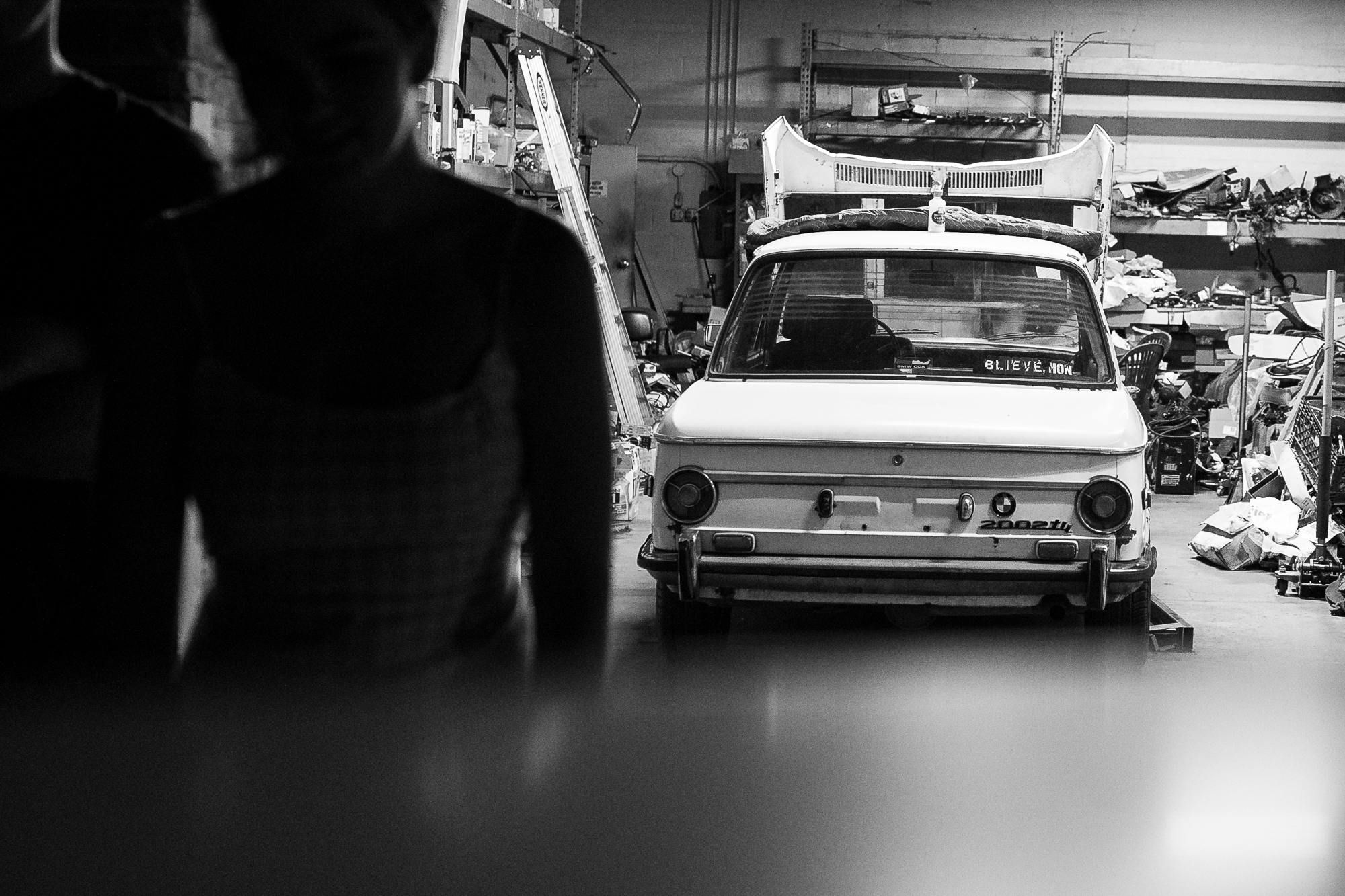
Word of mouth saw other friends show up to help. They were drawn partly by a large refrigerator of beer and partly by the appeal of working on an old car so far gone that wrong answers were impossible. Our pal Tim Skwiot drove his E30 in from Minnesota; Tim writes fuel-injection software as a hobby. My friend Owen Nelson, a software engineer just out of college, lives in Chicago but grew up in his father’s business, which just happens to be a BMW service and restoration mecca. Wegweiser lives in Pennsylvania, where he works for a storied BMW parts importer; he drove his barn-rat 2002 in from Pittsburgh at the last minute and somehow managed to not get arrested, despite averaging eleven million miles per hour through Ohio, land of turnpike authority, in a stickered-up snotrocket as conspicuous as a pregnant elephant.
Normal people, in other words.
Other area friends filtered in over the course of that first weekend—varied in age and focus, from early twenties to newly retired. Most had either restored or rebuilt an old BMW. Experience helped but was by no means necessary, owing to the virtually rule-free nature of the job at hand. That quality also made any timeline guess sound wildly optimistic, even when couched in pessimism. Early on, Ben guessed that it would take three or four weekends of work to make the car safe and drivable, so long as the labor avoided actual quality and erred toward slam fabrication and high-spirits triage. After a day of poking at the thing, everyone present seemed to agree.
Half of that first day was simple damage inventory. Panels were pulled and rust ground away in order to survey the remaining metal. The car’s body was so rotten as to be comically uplifting: holes big and small, holes both hidden and obvious, even holes that had somehow managed to grow and nurture their own private little collections of smaller and lower-ranked orbiting holes. (Late that first night, high on sleep dep and gin drinks, I named a few of them: Holey! Holeface McGee! Holevis Presley!) At least four feet of each outer floor edge was attached to the car solely by the factory seat mounts, these tiny steel bridges that tie floor to sill. Two of the four rear spring perches were so oxide-gnarly as to be moveable by hand. On top of all this lay typical needs: fuel lines both steel and rubber, brake and suspension work, driveshaft spinny bits, a new windshield to replace the cracked original.
Friday night, Ben walked to the back of the shop, gathering some of the steel he had ordered. A length of round tubing appeared first, 1.5 inches in diameter and 0.120-inch thickness. Then a length of rectangular tube, 0.083-wall, three inches wide.
“Alright,” he said, “Let’s drink some beer and design this s***.”

I knelt down, eyeing the metal. “Why these tubes?”
“Six feet is the longest UPS will ship—over that, the rate goes way up. I didn’t get you DOM, though. Way more expensive. This thing isn’t nice enough for that.”
“No, I mean, where are they going on the car?”
He shrugged. “I have plans.”
I stood up and absentmindedly kicked my foot into a hole in the right rocker. My shoe disappeared to the ankle.
“Tough, but fair.”
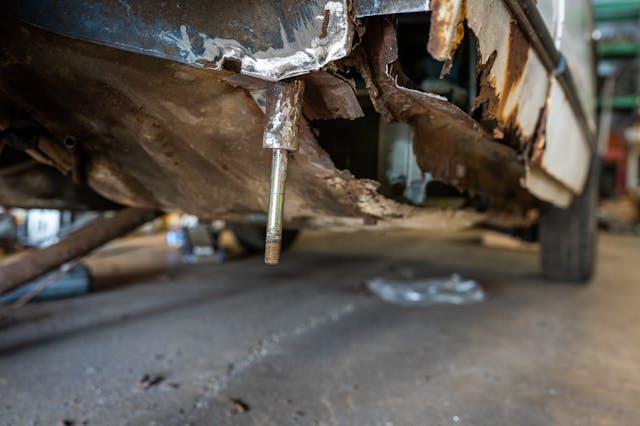
Ben, an engineer by training, laid out the changes with casual indifference; I served mostly as half-intelligent metal-prep and welding labor, plus a form of compass, setting project heading and cost but otherwise trusting everyone to do half-sensible work. Grinders were plugged in and cutoff discs screwed down; by early afternoon, the car was a swarm of humanity, three or four jobs running at once. Particulars were rare, save a few obvious and knee-jerk dictates as problems came up. (Sample exchange, random friend in shop: “You want me to clean this?” Me: “Make this car less visually upsetting and I will end you with a knife.”)
Budget was both true north on the project and the whole point. We don’t talk much about ownership cost around here, but classic cars require money to own and feed. That fact can make the hobby seem desperately out of reach, and the effect compounds if you want a machine even half wanted by everyone else. Nor does satisfaction necessarily track with spend. Intensely valuable cars best appreciated in regular use often mutate into precious garage queens, stagnant for months at a time.
Logical in one sense, a wastey bunch of hooey in another. I can’t afford a nice 2002tii. Years ago, when 1970s and 1980s BMWs were cheap, I burned through a baker’s dozen of the things. They meant something. I loved wrenching on and learning about them, but mostly, I loved how they drove.
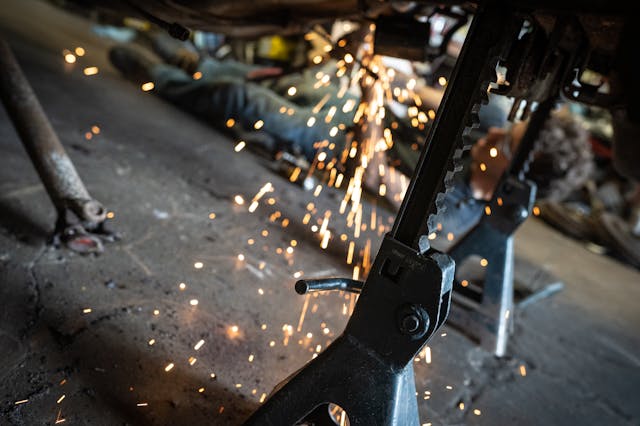
Those cars are no longer cheap. Complaining about this would be like moaning about the tide. Instead, as sparks flew, I decided the project would be a rejection of precious thinking, along a specific and personal arc:
- Lack of money can be a roadblock, unless you lower your standards so far as to leave the road being blocked
- Traditional standards of work and quality are generally important
- Except when they’re not
- Anything is possible with a welder
- Literally anyone can weld, if you don’t mind welding badly
- If the front door to a dream is locked, try a side window
- Cars should be a means to an end, not a silent museum to your own taste
- Wabi sabi
- Safety first.
As a unibody car, a 2002 draws torsional rigidity from its bodywork. The BMW has no frame, and the car’s thin pillars and bulkheads ensure that most of the tub’s load is carried by relatively simple rocker- and suspension-mount structures. Let a 2002 get rusty enough, the car will literally collapse. Best-case, some suspension piece falls off while parking, or the doors no longer shut. At worst, maybe the tub breaks in half on the freeway and the whole thing becomes a cheeky little rabbit-faced black hole of doom.
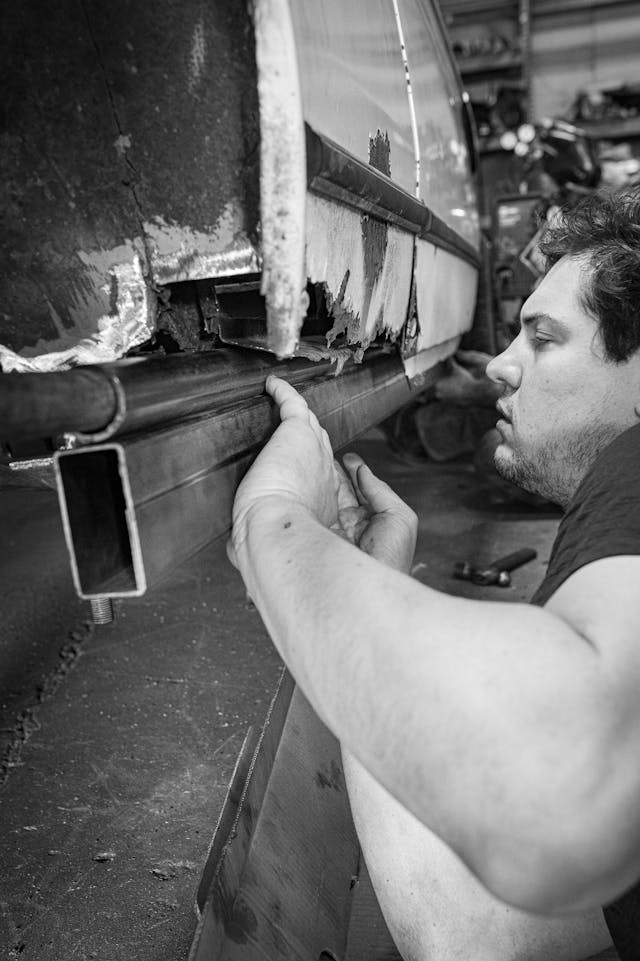
The white car wasn’t quite at black-hole status, but it wasn’t far off. Rust and at least one saltwater flood had reduced the box-section subframe mounts to mere bolts hanging from a decimated floor. Even if the rest of the car had been intact, road use would have ripped out that part of the floor, hanging the rear suspension by the differential. Which would, naturally, be very much surprised by that fact and probably just pack its bags and hat and set off for somewhere better, like the nearest ditch.
To remedy this, Ben and I landed on something like an exoskeleton. (“Load path,” Ben said. I nodded sagely, like a person who knows things.) The remains of the car’s rockers would be cut away, Ben decided, their spaces filled with a vertical sandwich of metal, one steel tube atop another. Each sandwich would then be plug-welded to the car through holes drilled in the door sills. The front end of the tubing would be fishmouthed onto another, vertically oriented tube welded in behind the front wheel and running parallel to the A-pillar. (“Oh,” I said to Ben, as he test-fit the steel, “Load path!” His face did a hugely accurate impression of Paul doing an impression of a person who has just seen an idiot.)

The rest of the fixes were relatively simple. Just forward of each rear wheel, each tube sandwich would tie into a new structure, each of which mimicked one of the original subframe boxes. The spring perches, the rotten left-front frame rail, and the rear shock towers would see welded-in “blanket” patches—not proper repairs, but steel hammered and stitched over rust holes, holding things together.
Chiefly, much of the rust would be left intact, mummified underneath, because $1800 car. And because, as Ben put it, “You don’t have $80,000 or years to do it right.”
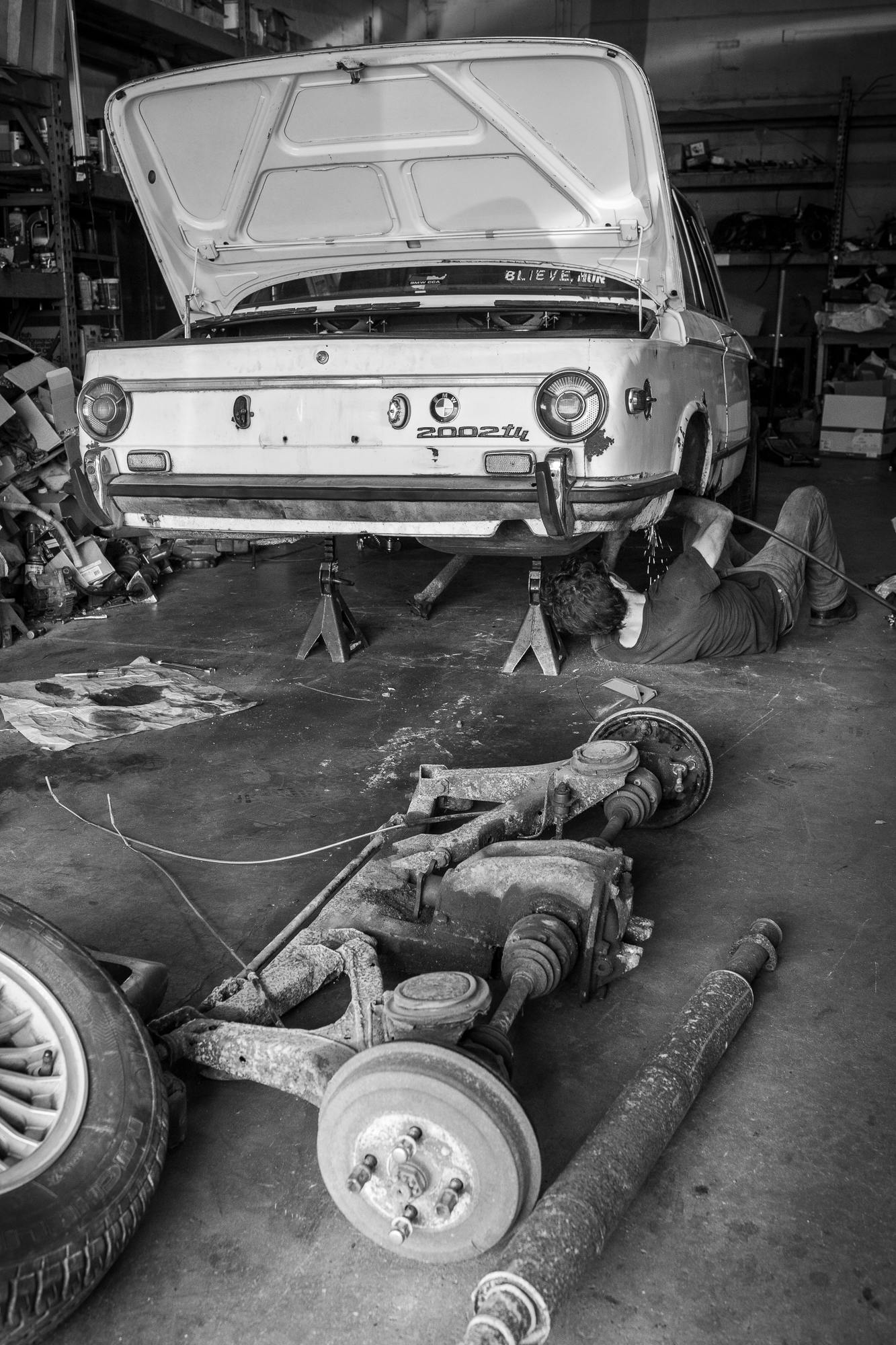
“How long,” I said, “until the thing is structurally dorked again, if I actually drive it?”
“Who knows? Unless you go chasing salt and rain… 20 years?”
“Am I a bad person if I don’t fix the giant floor holes? They’re fun.”
That shrug again. “This reminds me of the 1980s. A bunch of shops stopped working on 2002s when the cars were just coming apart from daily use. I always worked on them, I didn’t care. But you did have to find ways to make the, uh… discount repair happen.”
“That ‘one more winter’ thing.”
“A shock tower went on one of my dad’s cars, once. Punched through on a family trip. We had to get home, so he jammed it back in place with a block of wood.”
Paul, across the room: “I bought a car with some wood in it once!”
The whole thing reminded me of those times in grade school when I would slam together a plastic airplane model in a single afternoon, all glue mess and no paint, just to have something to play with.
“It should all be reversible,” Ben said later, as we poked at the sills, “just in case anyone ever actually loses their mind and tries to properly restore this thing.”
“No one should ever do that,” Paul yelled, from the back of the shop.
“Down, boy!” I said. “Back!”
“Arf!” he barked.
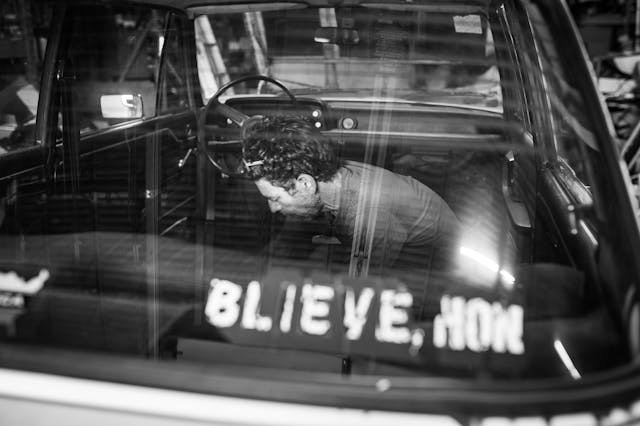
Paradoxically, the more we patched up the car, the bigger the holes got. I would take an idle moment and pick away at a fender or a floor, using a screwdriver or even just a fingernail to turn latticed oxide into air. It seemed fitting. Everything here mattered, except it didn’t. We were building a small protest, a driveable parts car, a quiet middle finger to… I couldn’t tell what, but it certainly felt like something. Next to real restorations or forum build threads, the project was both meek and unambitious, but I couldn’t stop thinking of places I wanted to drive the thing. Or on all the attainable cars and motorcycles I had wanted to try as a kid. Those years when you sit there, reading books or the internet, building a list and then waiting patiently for a job and funding—only then I grew older and got a job, and those machines had appreciated out of reach.
Miles seemed like a good goal. A lot of miles. Maybe aim for more in a year than most internet builds see in a lifetime.
Start at the bottom, nowhere to go but up.
I mentioned this fact in our last installment, but the BMW’s paper file holds evidence that the car was purchased new by James Taylor. The Massachusetts songwriter.

The odds seemed long and the fact trivial, but as the BMW shed metal, songs began. Little tunes sung to no one while working, over a grinder or behind a welding mask, hummed or bellowed as mood required. The glory of diving down a rabbit hole:
Just yesterday morning
I saw your floors, they were gone
Sh*tbox, the miles they made put an end to youuuu
Flushed the throne this morning
And I wrote down this song
Then I huffed some floor-tar melt and felt better nowwwwwwwww
I made three more trips to Chicago. It got so much better. And at the same time—this should come as no surprise—it got so very, very much worse.
To be continued…
